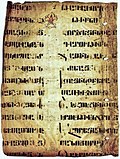Classification by Hrachia Acharian

Classification des dialectes arméniens (Classification of Armenian dialects) is a 1909 book by the Armenian linguist Hrachia Acharian, published in Paris. [1] It is Acharian's translation into French of his original work Hay Barbaṙagitutʿiwn ("Armenian Dialectology") that was later published as a book in 1911 in Moscow and New Nakhichevan. The French translation lacks dialectal examples. An English translation was published in 2024. [2]
Acharian surveyed the Armenian dialects in what is now Turkey, Armenia, Georgia, Iran, Azerbaijan and other countries settled by Armenians.
Unlike the traditional division of Armenian into two dialect groups (Western Armenian and Eastern Armenian), he divided Armenian into three main dialect groups based on the present and imperfect indicative particles that were used. He called as the -owm (-ում) dialects, -gë (-կը) dialects, and -el (-ել) dialects.
After the Armenian genocide, linguists Gevorg Jahukyan, Jos Weitenberg, Bert Vaux and Hrach Martirosyan have extended the understanding of Armenian dialects.
Map

List
-owm dialects
-el dialects
-el dialects | |||||||
Dialect | Areas spoken(country and city names as of 1909) | ||||||
| 1 | Maragha | ||||||
| 2 | Khoy | Zangezur settlements: Kori, Alighuli, Mughanjugh, Karashen, Alilu, Angeghakot, Ghushchi-Tazakend, Tazakend, Uz, Mazra, Balak, Shaghat, Ltsen, Sisian, Nerkin Kilisa | |||||
| 3 | Artvin | ||||||

